Thai Yoga Massage
What is Thai Yoga Massage?
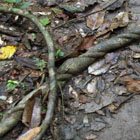
It originated in India over 2500 years ago based on Ayurvedic Medicine. Ayurvedic is a holistic system of traditional medicine classified in Western medicine as a complementary and alternative medicine (CAM) that complements, rather than replaces, treatments prescribed by a physician. Thai Yoga Massage is the manual medicine branch of traditional Thai medicine emphasizing prevention.
Thai Yoga Massage combines elements of yoga (deep stretching), shiatsu, reflexology and acupressure working with the energy pathways of the body and the therapy points located along those pathways. The series of acupressure, reflexology, shiatsu and deep stretching that are performed was developed by Kam Thye Chow, Founder of the Lotus Palm Centre in Quebec, Canada. Rosalind’s approach follows Kam’s methodology being very concise, compassionate and safe. Read this interesting article about Thai Yoga Massage: Inside New Jersey on NJ.com.
What are some of the benefits?
Massage combined with deep stretching is excellent for relieving muscle tension. It helps open and repair joints and connective tissue. Thai Yoga Massage is very relaxing and meditative helping to center the mind and body.
You will experience: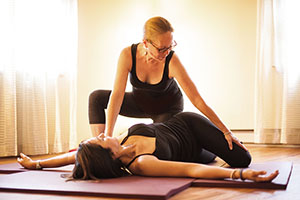
– deep relaxation
– stress reduction
– improved circulation
– increased energy
– increased flexibility
– improved range of motion
Who would benefit from a Thai Yoga Massage?
Anyone, with the exception of those with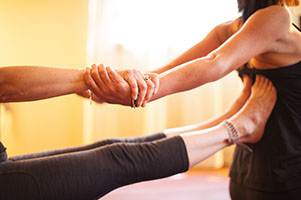 a serious illness, recent surgery or injury will benefit from the restorative quality of Thai Yoga Massage. It is especially helpful to athletes who work their bodies in repetitive ways such as running, tennis, gym/weight lifting, cross training just to name a few. Those yogis out there who have experienced a Thai Yoga Massage have a special appreciation for how it opens up tight areas, produces deep relaxation and greater freedom of movement.
a serious illness, recent surgery or injury will benefit from the restorative quality of Thai Yoga Massage. It is especially helpful to athletes who work their bodies in repetitive ways such as running, tennis, gym/weight lifting, cross training just to name a few. Those yogis out there who have experienced a Thai Yoga Massage have a special appreciation for how it opens up tight areas, produces deep relaxation and greater freedom of movement.
Many people who have sustained an injury, or mental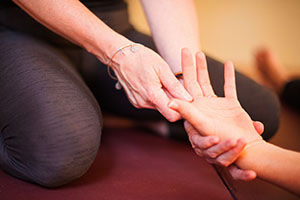 trauma, are under stress, or have chronic physical problems such as Fibromyalsia, Lyme disease, Multiple Sclerosis and Parkinson’s find their nervous system has locked parts of their bodies into a permanent spasm making it impossible to heal completely. The bodywork helps release the nervous system so that the body can relax into a position of healing.
trauma, are under stress, or have chronic physical problems such as Fibromyalsia, Lyme disease, Multiple Sclerosis and Parkinson’s find their nervous system has locked parts of their bodies into a permanent spasm making it impossible to heal completely. The bodywork helps release the nervous system so that the body can relax into a position of healing.
If you are currently recovering from surgery Thai Yoga Massage is not recommended until you have healed properly. Once that takes place a Thai massage can be a wonderful way to release the stress and trauma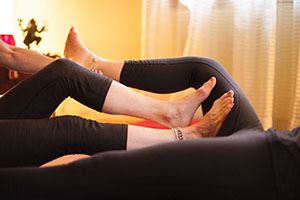 that the body experienced undergoing the procedure.
that the body experienced undergoing the procedure.
How is Thai Yoga Massage performed?
Thai Yoga Massage is performed fully clothed on a cushioned mat on the floor, without oils or creams. Comfortable clothing allowing freedom of movement – such as yoga or exercise clothing – should be worn (no shorts). Jewelry such as bracelets, necklaces and watches should be removed. The recipient simply relaxes on the comfortable mat while the Thai Yoga practitioner does all the work.
What method of Thai Yoga Massage is performed?
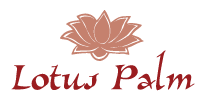 Rosalind’s training is in the Lotus Palm School of Thai Yoga Massage method. It is a series of traditional northern Thai Yoga Massage techniques. The series of stretching and massage exercises were designed by Kam Thye Chow, Founder of the Lotus Palm Centre in Quebec, Canada. He built the series to be very concise, compassionate and safe. Kam Thye Chow specifically integrated the Eastern knowledge of the mind, body and spirit with the Western understanding of the body.
Rosalind’s training is in the Lotus Palm School of Thai Yoga Massage method. It is a series of traditional northern Thai Yoga Massage techniques. The series of stretching and massage exercises were designed by Kam Thye Chow, Founder of the Lotus Palm Centre in Quebec, Canada. He built the series to be very concise, compassionate and safe. Kam Thye Chow specifically integrated the Eastern knowledge of the mind, body and spirit with the Western understanding of the body.
Rosalind personally finds providing Thai Yoga Massage to her clients to be very rewarding while at the same time very meditative and calming. Rosalind invites you consider experiencing a relaxing, therapeutic, Thai Yoga Massage for yourself. She would be happy to answer any questions you have and set up an appointment. Much Metta.
Thai Yoga Massage Photos, Joe Sbarro
www.JosephSbarro.com
Please be aware that Yoga, Reiki, Shamanic energy work and Thai Yoga Massage are Complimentary Alternative Medicines and should never be substituted for seeking medical advice and treatment for injuries or physical or mental illnesses.